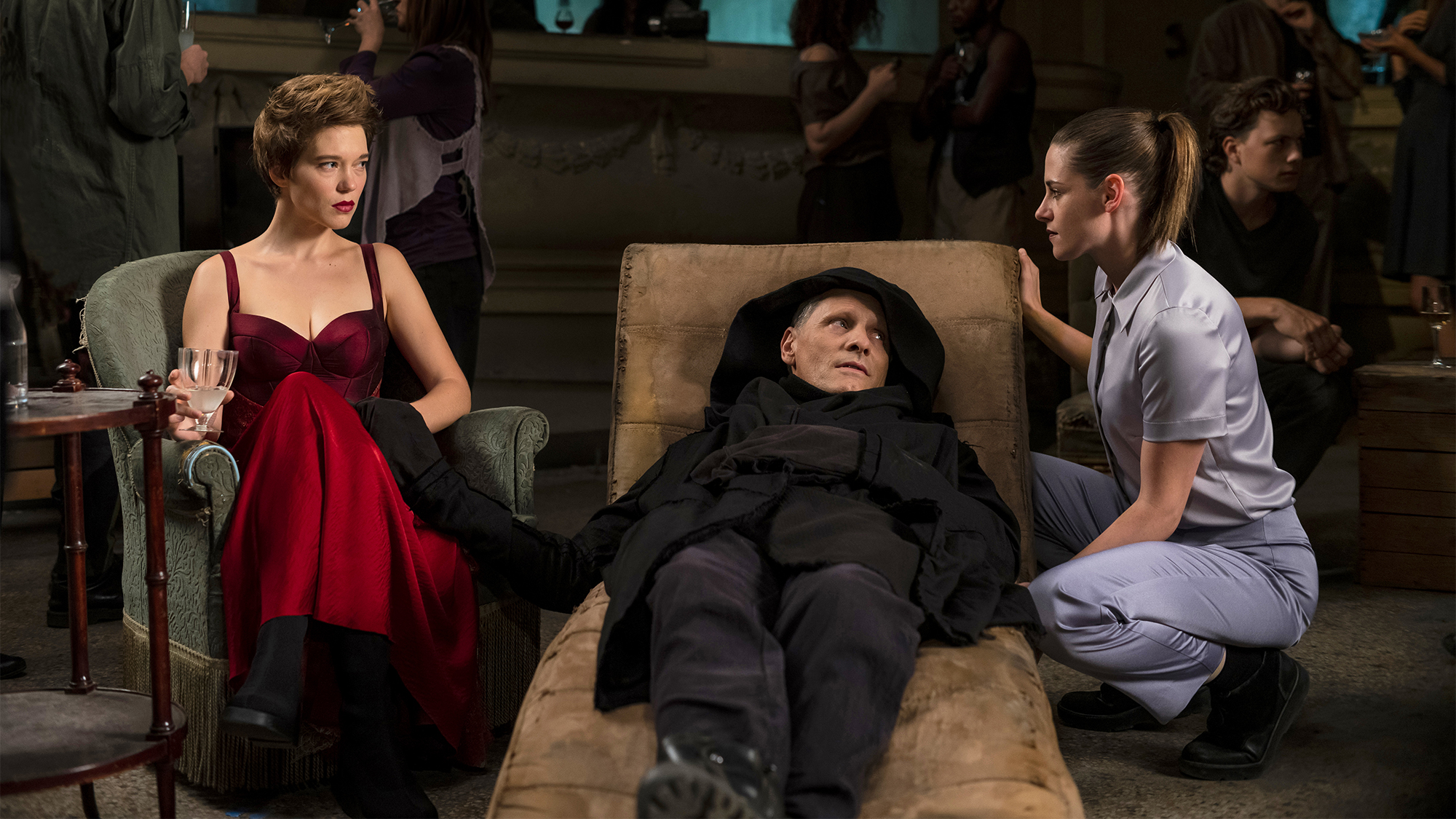The stakes could not be higher. The human race is evolving in rapid, unexpected, often grotesque ways. Some no longer even feel pain; they slice one another open on darkened streets to experience whatever sensations have taken its place. An unspecified ecological disaster has doused the Earth in perpetual gloom. Shadowy political sects seek to capitalize on the confusion, while government agents prepare to stamp out the emergence of a potentially post-human species. In this terrifying yet exciting new society, there’s naturally only one question on everyone’s mind: What is art?
Turns out, David Cronenberg is an optimist. The decline of Western civilization may be a bitch, his latest film implies, but after the fall we all can kick back and talk aesthetics and indulge new forms of omnisexual hunger. (New forms of regular hunger too: Some newly evolved folks can digest plastic.) Crimes of the Future has been faulted for a languid storyline that, like it or not (and why not, my overly goal-oriented friends?), deliberately undercuts the urgency of its own premise. Yes, plots and counterplots are hatched, a child is smothered onscreen, drills enter the skulls of the misfortunate, and even casual conversations feel conspiratorial. But the likelihood of some society-rupturing conflagration feels impossibly distant, and so we stroll casually through a roomy dystopia that wouldn’t much bother anyone who lived on the Lower East Side in the ’80s. For a world in perpetual flux, it’s emotionally static.
Embodying that paradox is a man who blurs the line between stoic and passive, Viggo Mortenson’s Saul Tenser. (And how exactly has that name never been used for a dystopian antihero before?) Saul spontaneously generates new organs in his sleep, a process that afflicts him with a possibly sensual discomfort and requires that he spend his nights in a device that’s a little Naked Lunch-able and somewhat Whovian. It’s a computerized pod where latched tentacles perpetually jostle him. (Honestly, every aging man could probably use one, not to mention the similarly designed adult high-chair that feeds Tenser. Are there tentacles that put on your socks, too?) Cloaked as though the Jedi Council has dispatched him to end an intergalactic trade embargo, Tenser communicates largely through croaks and groans which sometimes form the shape of short sentences, exerting himself with the exasperated strain of a dying man who’s also immortal.
Tenser is also an artist, and he performs in the sort of drab basements where you’ve seen terrible punk bands, along with his partner (accomplice?), Caprice (Léa Seydoux), who’s also the closest the film comes to a conscience. A former surgeon, Caprice slices into her partner via a squishily tortoise-like remote control, fiddling about till she lifter-pullers a new growth from his bowels. It’s a pretty good show, a combo of Karen Finley and Operation. Offstage, Caprice also classifies and tattoos each of Saul’s new organs, monitoring his discomfort with increasing uneasiness.
After Caprice extracts a particularly noteworthy gland from Saul’s innards, the duo visit the government’s newly established Registry of Organs. In this gray office, amid musty filing cabinets and sheafs of forgotten documents, the artists’ transgressive celebrity immediately seduces two functionaries. Don McKellar’s Wippet is a Jordan Peterson lookalike who wriggles with submissive officiousness, while Kristen Stewart’s Timlin is sniveling yet intense—finally, the hot lesbian Peter Lorre the 21st century deserves. (Stewart hasn’t been so carnally fidgety since… Into the Wild maybe?) “Surgery is the new sex,” Timlin gasps pretentiously to Tenser, palpably eager to... well, do something with, or to, or at him.
A murdered boy’s father (Scott Speedman) seeks out Saul and Caprice to propose a new addition to their act, nudging the plot reluctantly forward. Investigating this death and carrying out other miscellaneous errands gives the artists an excuse to encounter plenty of extravagantly stylized weirdos. As the dead kid’s mom, Lihi Kornowski is refreshingly contemptuous about all this art and evolution nonsense. (Though keep in mind she’s also a cold-blooded murderer.) Welket Bungué is laconic and relaxed as the cop keeping tabs on the latest biological developments with the New Vice Unit—a fancy name, he explains, chosen so they could get more funding. Two deadpan techs (Tanaya Beatty and Nadia Litz) turn giddy at the sight of the vintage autopsy pod Saul and Caprice use for their performances, frolicking like they’ve been given the opportunity to bang in the back of a ‘57 Chevy.
As MacGuffins nest within MacGuffins, Saul and Caprice develop artistic differences. Tenser is recruited for an “Inner Beauty” pageant that may or may not be a cover for a pro-evolution insurgency but is almost certainly a form of sellout for the hooded aesthete. The intrigue of a demimonde where fashionable people have their faces surgically sculpted ensnares Caprice. Both feel betrayed that the other let someone else take a blade to them.
And so Crimes of Future noses around with grimly amused curiosity, leaving a messy browser full of open tabs in its wake. There are just so many new holes to probe, it’s hard to know where to start. Or to start. Timlin’s too-pithily trend-piece summation is right: Surgery is sex now. But Cronenberg also explores surgery as magic act, magic act as conceptual art, conceptual art as avant-garde porn. “Body horror” feels like a tired tag for a movie that’s less gruesome than you’d expect, maybe even a little less than I’d hoped. There’s rarely blood when there’s guts, rarely guts when there’s blood. As usual with Cronenberg, what’s more disconcerting than the fusion of human and tech is how much it turns everyone on. No director has ever so boldly dared you not to kink shame.
Less post-apocalyptic than nostalgic for past ends of past worlds, Crimes of the Future is perturbed with how history is always intruding even after it’s supposedly reached its climax. The cutting edge of body horror, Julia Ducournau’s Titane, feels briskly contemporary, obsessing over how our post-human technolust inflects our performance of gender and shapes our identity. But the 79-year-old Cronenberg is content to autopsy several decades worth of his own obsessions, happily boring into male torsos, rummaging around inside, and reporting his inconclusive findings.
Even in this new realm of polymorphic perversity, men retain certain privileges. Tenser may be the body on the table, acted upon by Caprice, but to his fans, he’s still the artist. When Bungué’s detective, who’s perhaps more traditional aesthetically, would prefer to give Caprice credit, a besotted Timlin is outraged. And art scenes are no less catty or insular in the future. When an associate at one underground club asks Tenser how he enjoyed the night’s show—a crowd-pleasing dancer decked out in multiple ears who gyrates to pretentious ethnotrance—Saul replies bitchily that it’s fine “if you like escapist propaganda.” I mean, the ears aren’t even functional. You call that art?
At the center of it all gapes Tenser’s mystifying abdomen, spread open wide like the vaginal gash that so startled James Woods when it spontaneously parted his guts in Videodrome 40 years ago. Cronenberg was still playing off fears of penetration back then: Woods’s cable-smut hustler was (not unreasonably!) terrified by his metamorphosis. A handgun and a VHS cassette phallically entered slots in his male flesh. His entire being was nonconsensually reprogrammed. And whatever womb churned inside promised only the most violent form of regeneration.
But Tenser is almost beatifically receptive to his transformation; his change comes from within, just like spiritual quacks are always telling us it should. In one shot (accidental, Cronenberg insists) he even resembles Maria Falconetti in Dreyer’s The Passion of Joan of Arc, a saint transfigured through suffering. Cronenberg is too level-headed to push the point, not to mention too restless; instead it’s another image tossed on the heap of ’em, to be sorted through at our leisure whenever the world finally gets around to ending.
Crimes of the Future is now playing in area theaters. See the rest of our movie listings here.






